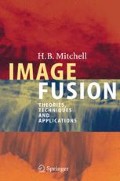Abstract
The subject of this chapter is image fusion using the methods of ensemble learning. Ensemble learning is a method for constructing accurate predictors or classifiers from an ensemble of weak predictors or classifiers. In the context of image fusion, we use the term ensemble learning to denote the fusion of K input images I k ,k ∈ {1,2, . . .,K}, where the I k are all derived from the same base image I*. The I k themselves highlight different features in I*. The theory of ensemble learning suggests that by fusing together the I k we may obtain a fused image with a substantially improved quality. In the first part of the chapter we consider methods for constructing I k . In the second part we consider methods for fusing the I k .
Access this chapter
Tax calculation will be finalised at checkout
Purchases are for personal use only
Preview
Unable to display preview. Download preview PDF.
References
Bay, S.D.: Nearest neighbor classification for multiple feature subsets. Intell. Data Analy. 3, 191–209 (1999)
Domeniconci, C., Yan, B.: Nearest neighbor ensemble. In: Proc. 17th Int. Conf. Patt. Recogn. (2004)
Giannarou, S., Stathaki, T.: Edge detection using quantitative combination of multiple operators. In: IEEE Workshop on Signal Process. Systems Design and Implement, pp. 359–364 (2005)
Hong, Y.: Random spatial sampling and majority voting based image thresholding. IEEE Signal Process. Lett. (2008)
Jarillo, G., Pedrycz, W., Reformat, M.: Aggregation of classifiers based on image transformations in biometric face recognition. Mach. Vis. Appl. 19, 125–140 (2008)
Ko, A.H.-R., Sabourin, R., de Britto Jr., A.S.: Compound diversity functions for ensemble selection. Int. J. Patt. Recogn. Art. Intell. 23, 659–686 (2009)
Krogh Vedelsby (1995)
Liu, C.-L., Marukawa, K.: Normalization ensemble for handwritten character recognition. In: Proc. 9th Int. Workshop on Frontiers in Handwriting Recogn. (2004)
Kuncheva, L.I.: Combining pattern Classifiers: Methods and Algorithms. John Wiley and Sons, Chichester (2004)
Mayo, M.: Random convolution ensembles. In: Ip, H.H.-S., Au, O.C., Leung, H., Sun, M.-T., Ma, W.-Y., Hu, S.-M. (eds.) PCM 2007. LNCS, vol. 4810, pp. 216–225. Springer, Heidelberg (2007)
Melgani, F.: Robust image binarization with ensembles of thresholding algorithms. J. Elect. Imaging 15, 023010 (2006)
Nanni, L., Lumini, A.: Fusion of color spaces for ear authentication. Patt. Recogn. 42, 1906–1913 (2009)
Okum, O., Valentini, G.: Supervised and Unsupervised Ensemble Methods and Their Applications. Springer, Heidelberg (2008)
Orlov, N., Shamir, L., Macura, T., Johnston, J., Eckley, D.M., Goldberg, I.G.: WND-CHARM: Multi-purpose image classification using compound image transforms. Patt. Recogn. Lett. 29, 1684–1693 (2008)
Oza, N.C., Tumer, K.: Classifier ensembles: select real-world applications. Inf. Fusion 9, 4–20 (2008)
Rohlfing, T., Maurer Jr., C.R.: Multiclassifier framework for atlas-based image segmentation. Patt. Recogn. Lett. 26, 2070–2079 (2005)
Sharifi, M., Fathy, M., Mahmoudi, M.T.: A classified and comparative study of edge detection algorithms. In: Proc. Int. Conf. Information Technology: Coding and Computing, pp. 117–120 (2002)
Rokach, L.: Taxonomy for characterizing ensemble methods in classification tasks: A review and annotated bibliography. Comp. Stat. Data Anal. 53, 4046–4072 (2009)
Wang, H., Suter, D.: False-peaks-avoiding mean shift method for unsupervised peak-valley sliding image segmentation. In: Proc 7th Digital Image Computing: Techniques and Applications, pp. 581–590 (2003)
Rights and permissions
Copyright information
© 2010 Springer-Verlag Berlin Heidelberg
About this chapter
Cite this chapter
Mitchell, H.B. (2010). Ensemble Learning. In: Image Fusion. Springer, Berlin, Heidelberg. https://doi.org/10.1007/978-3-642-11216-4_10
Download citation
DOI: https://doi.org/10.1007/978-3-642-11216-4_10
Publisher Name: Springer, Berlin, Heidelberg
Print ISBN: 978-3-642-11215-7
Online ISBN: 978-3-642-11216-4
eBook Packages: EngineeringEngineering (R0)

